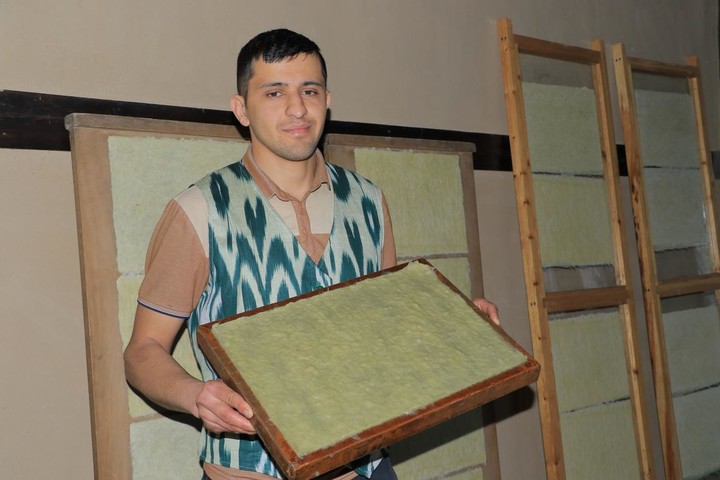Samarkand paper became widely popular in the Eastern world alongside Egyptian paper. This was particularly evident in the 9th–10th centuries when many Persian and Arabic manuscripts and ancient texts were written on Samarkand paper.
For over a thousand years, the papermakers of Samarkand elevated their craft to the level of fine art. They developed unique methods to produce some of the world’s thinnest, smoothest, most ink-resistant, and durable paper. One renowned variety, “Samarkand Sultan Paper,” stood out for its exceptional thinness, white color, subtlety, and softness. Another variety, “Samarkand Silk Paper,” shared its fine quality but was distinguished by its light-yellow hue. “Mir Ibragimi” paper featured watermarks in the form of a white ring, while the “Nimkanop” variety had a distinct cinnamon color, attributed to its production using silk wastes with the addition of admixtures. Cotton, silk, and mulberry bark were the primary raw materials used in crafting these papers.
Timurid prince Zahiriddin Muhammad Babur, founder of the Mughal Empire in the Indian subcontinent, praised Samarkand paper in his memoir, Baburnama:
“The finest paper in the world comes from Samarkand. The water for Juvoz paper flows from Konigil, a site along the Siab River, also known as the Obi Rahmat.”
In 1995, during UNESCO’s international conference on “Preservation of Historical Monuments” held in Kogon, Bukhara, special attention was given to reviving the traditional crafts of applied arts. Among the participating artisans was Zarif Mukhtarov from Samarkand, who presented a project to restore the long-lost art of Samarkand papermaking.
After extensive research into historical manuscripts and ancient libraries and studying papermaking techniques worldwide, Mukhtarov, a descendant of a family of craftsmen, embarked on a mission to revive this art in his home.
Between 1995 and 2002, Mukhtarov mastered the intricate process of creating Samarkand paper through numerous trials and experiments. With support from the government, UNESCO, and Japan’s JICA agency, he established the “Konigil-Meros” papermaking center in Konigil village, located along the Siab River. Today, the center produces a variety of Samarkand papers using the bark of the “Balh mulberry,” a fruit-bearing tree native to Central Asia.
The process of making Samarkand paper is both labor-intensive and rewarding. Mulberry branches are soaked for several days, then peeled, and the rough outer bark is scraped off with knives, leaving behind yellowish inner bark. This is boiled for 5–6 hours, then pounded into large stacks until it turns into a uniform, dough-like substance using wooden mallets for 7–8 hours.
The fibers are stirred with Siab water in large vats and filtered through rectangular sieves. The wet sheets are pressed for 8–10 hours. The dried paper is durable, but to smoothen any roughness, craftsmen polish it on a marble table using either a piece of marble or bone horn, rendering Samarkand paper smooth.
Today, under the leadership of Zarif Mukhtarov, young artisans from the local community work at the “Konigil-Meros” center, located on the outskirts of Samarkand. By reviving the production of this ancient craft, the center preserves the legacy of their ancestors, who once showcased their remarkable artistry to the world. This effort has earned widespread admiration and continues to attract significant interest from international visitors to Samarkand.=-op[

